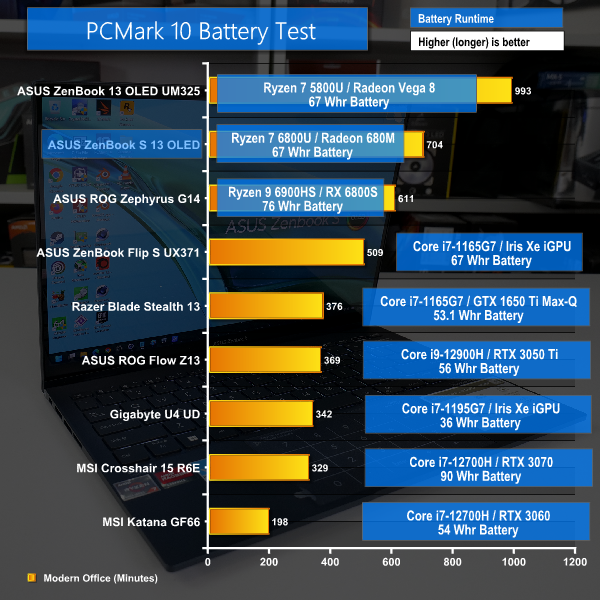Temperatures, Clocks, and Power
ASUS takes the 15-28W-capable Ryzen 7 6800U processor and slings it inside a sub-15mm, 1kg chassis. So, it is unsurprising to see that we have some sensible power restraints being applied.
Under sustained, all-core loading from Cinebench R23, we see the Ryzen 7 6800U typically operating at around 25W up until roughly the 10-minute mark. It then drops down to around 22-23W sustained all the way to termination of our test run at 30 minutes.
Package power of 25W for the first 10 minutes gives 2.9GHz all-core, then the 23W from there on is 2.8GHz all-core.
Given the physical size limitations of ASUS’ ZenBook S 13 design, I’d say that these sorts of speeds, power tolerances, and temperatures well below 90 degrees – which means no thermal throttling – are all good positives. But let’s see how the performance numbers present.
As a quick side note, we tested the laptop in its Performance power mode that is intended to ramp up package power and fan speeds. This resulted in basically identical performance for our test machine with the latest BIOS and Windows updates. So, we stuck to Balanced for the duration of testing, except iGPU gaming.
The competing Intel-based Samsung laptop was far less willing to deploy power to its Core i7-1260P processor. Initial boost saw the usual Intel loftiness, but the machine dropped to between 16W and 19W within the duration of a single Cinebench R23 nT run. And it then stabilised at around the 4-minute mark to its long-duration CPU package power level of 13W.
Noise
You can see an example of our noise testing result in the video review.
I have no problem with the noise levels output by ASUS’ chassis. There’s ample cooling capacity available when needed to keep the chip running at sensible power levels and thermals. And when idle or web browser conditions are present, the fan setup spins down to effectively inaudible levels
There’s no annoying frequent jumping up and down of fan speeds, either, and that’s the most important factor for an ultraportable laptop.
SSD
ASUS takes advantage of AMD’s new platform supporting PCIe Gen 4 by deploying a competent Samsung SSD.
5GBps writes and reads over 6GBps will do very nicely. That’s a really good platform improvement versus previous generation Ryzen U-series.
Battery
AMD specifically targeted performance-per-Watt and power efficiency as some of its pillars for Ryzen 6000 Mobile, and we see the dividends paying off with excellent battery life results from the Ryzen 7 6800U-powered ASUS ZenBook S 13 OLED.
Bear in mind that this laptop uses a premium 2.8K OLED touchscreen. So, it isn’t going to match the system runtime of the Ryzen 7 5800U ZenBook with its 1080p panel.
Nevertheless, over 11 hours of runtime from a 2.8K screened ultraportable is exceptionally good. That’s a full working or university day from the 67 Whr battery, plus some messing around time for the commute.
So, AMD’s power efficiency improvements for Ryzen 6000 Mobile look to have worked. It’s just a slight shame that the battery test repeatedly failed on the Intel-based Samsung competitor, so we couldn’t get a direct comparison unfortunately.
 KitGuru KitGuru.net – Tech News | Hardware News | Hardware Reviews | IOS | Mobile | Gaming | Graphics Cards
KitGuru KitGuru.net – Tech News | Hardware News | Hardware Reviews | IOS | Mobile | Gaming | Graphics Cards








